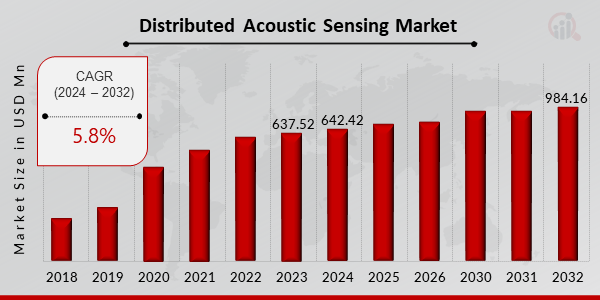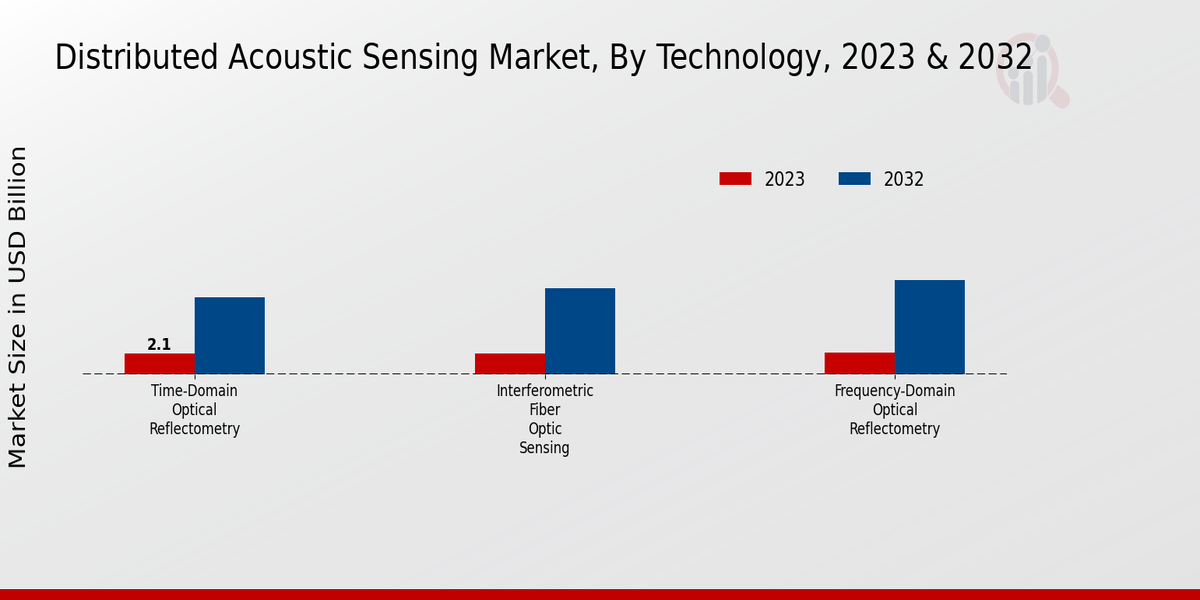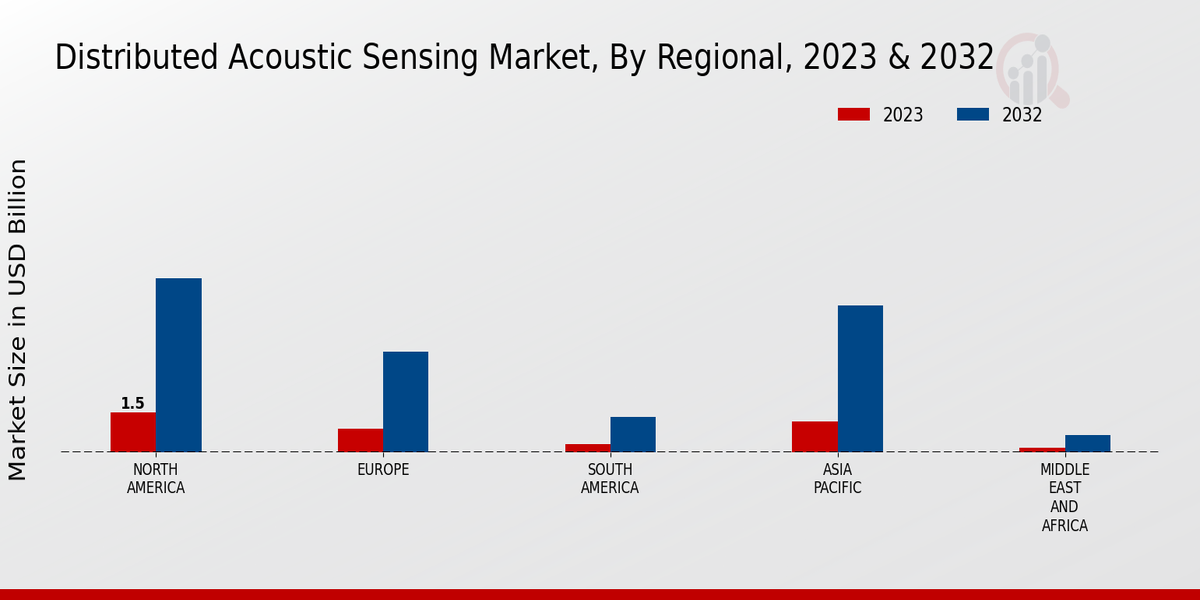Global Distributed Acoustic Sensing Market Overview:
Distributed Acoustic Sensing Market Size was estimated at 637.52 (USD Million) in 2023 The Distributed Acoustic Sensing Market Industry is expected to grow from 642.42 (USD Million) in 2024 to 984.16 (USD Billion) by 2032. The Distributed Acoustic Sensing Market CAGR (growth rate) is expected to be around 5.8% during the forecast period (2024 - 2032).
Key Distributed Acoustic Sensing Market Trends Highlighted
The increasing demand for real-time monitoring and security in various industries drives the Distributed Acoustic Sensing market. Key market drivers include the rising adoption of DAS in oil and gas exploration, pipeline monitoring, and perimeter security. Additionally, the growing need for condition-based monitoring and predictive maintenance in industrial facilities is fueling market demand.
Opportunities for exploration include the development of advanced DAS technologies that offer improved sensitivity, spatial resolution, and range. These advancements are expected to expand the applicability of DAS in new industries, such as healthcare and environmental monitoring.
Recent trends in the DAS market include the integration of artificial intelligence (AI) and machine learning (ML) algorithms for data analysis and anomaly detection. These technologies enhance the efficiency and accuracy of DAS systems, enabling real-time decision-making and proactive maintenance. Furthermore, the growing awareness of DAS benefits in critical infrastructure protection is driving market growth, as it provides continuous monitoring and early warning systems for potential threats.

Source: Primary Research, Secondary Research, MRFR Database and Analyst Review
Distributed Acoustic Sensing Market Drivers
Technological Advancements in Sensing Technologies
The Distributed Acoustic Sensing Market Industry is primarily driven by the rapid advancements in sensing technologies. The development of more sensitive and accurate sensors has enabled the detection of smaller and more subtle vibrations, making DAS systems more effective for a wider range of applications. Additionally, the integration of advanced signal processing techniques and machine learning algorithms has enhanced the ability of DAS systems to analyze and interpret data, leading to improved performance and reliability.
These technological advancements are expected to continue driving the growth of the Distributed Acoustic Sensing Market Industry in the coming years.
Increasing Demand for Infrastructure Monitoring
The growing need for efficient and cost-effective infrastructure monitoring is another key factor driving the Distributed Acoustic Sensing Market Industry. DAS systems offer a unique solution for monitoring the integrity of critical infrastructure assets, such as pipelines, bridges, and power lines. By continuously monitoring these assets, DAS systems can detect potential issues early on, allowing for timely maintenance and repairs. This helps to prevent catastrophic failures and ensures the safety and reliability of infrastructure.
As the demand for infrastructure monitoring continues to increase, the Distributed Acoustic Sensing Market Industry is expected to benefit significantly.
Growing Adoption in the Oil and Gas Industry
The oil and gas industry is a major adopter of DAS technology, and its continued growth is expected to drive the Distributed Acoustic Sensing Market Industry. DAS systems are used for a variety of applications in the oil and gas industry, including pipeline monitoring, leak detection, and reservoir characterization. By providing real-time data on the condition of pipelines and other assets, DAS systems help to ensure the safety and efficiency of oil and gas operations.
As the oil and gas industry continues to expand, the demand for DAS systems is expected to increase, contributing to the growth of the Distributed Acoustic Sensing Market Industry.
Distributed Acoustic Sensing Market Segment Insights:
Distributed Acoustic Sensing Market Technology Insights
Technology Segment Insights and Overview The Distributed Acoustic Sensing Market is segmented by technology into Interferometric Fiber Optic Sensing, Frequency-Domain Optical Reflectometry, and Time-Domain Optical Reflectometry. The Interferometric Fiber Optic Sensing segment held the largest market share in 2023 and is expected to continue its dominance throughout the forecast period. This dominance is attributed to the high accuracy and sensitivity of Interferometric Fiber Optic Sensing technology, making it suitable for applications such as pipeline monitoring, perimeter security, and structural health monitoring.
Frequency-Domain Optical Reflectometry is another significant technology segment in the Distributed Acoustic Sensing Market. This technology offers advantages such as long-range sensing capabilities and immunity to environmental noise, making it ideal for applications such as power line monitoring and oil and gas exploration. Time-Domain Optical Reflectometry is a complementary technology to Frequency-Domain Optical Reflectometry, providing high-resolution sensing capabilities. It is commonly used in applications such as fiber optic cable testing and fault detection.
The Distributed Acoustic Sensing Market is expected to witness significant growth in the coming years, driven by the increasing demand for real-time monitoring and security solutions across various industries. This growth will be fueled by the rising adoption of Distributed Acoustic Sensing technology in sectors such as oil and gas, energy, transportation, and security.

Source: Primary Research, Secondary Research, MRFR Database and Analyst Review
Distributed Acoustic Sensing Market Application Insights
Application Segment Insights and Overview The Distributed Acoustic Sensing Market is segmented into various applications, including Pipeline Monitoring, Perimeter Security, Seismic Monitoring, Oil and Gas Exploration, and Structural Health Monitoring. Among these, Pipeline Monitoring is anticipated to dominate the market, with a projected revenue of USD 6.1 billion by 2024. This growth is attributed to the increasing need for pipeline integrity management and the ability of DAS to detect leaks, corrosion, and other anomalies in real time.
Perimeter Security is another significant application segment, driven by the growing demand for enhanced security measures in critical infrastructure, military bases, and industrial facilities. Seismic Monitoring is also gaining traction, particularly in regions prone to earthquakes and volcanic activities, as DAS provides valuable data for early warning systems and hazard assessment. In the Oil and Gas industry, DAS is utilized for reservoir characterization, production optimization, and leak detection, contributing to the segment's growth. Structural Health Monitoring is expected to witness steady growth as the technology finds applications in bridges, buildings, and other critical structures, enabling continuous monitoring and early detection of potential issues.
Distributed Acoustic Sensing Market Deployment Mode Insights
The deployment mode segment of the Distributed Acoustic Sensing Market is categorized into permanent and temporary. Permanent deployment involves the installation of DAS systems for long-term monitoring and surveillance applications. This mode is commonly used in critical infrastructure protection, border security, and pipeline monitoring, where continuous real-time data is essential. The Distributed Acoustic Sensing Market revenue for permanent deployment is projected to reach USD 6.2 billion by 2024, exhibiting a significant market share.
On the other hand, temporary deployment refers to the installation of DAS systems for short-term or project-specific applications. This mode is suitable for events, construction sites, and emergency response situations where real-time data is required for a limited duration. The Distributed Acoustic Sensing Market data for temporary deployment is estimated to reach USD 4.1 billion by 2024, indicating substantial market growth. The adoption of temporary DAS solutions is driven by the increasing need for flexible and cost-effective monitoring solutions in various industries.
Distributed Acoustic Sensing Market Fiber Type Insights
The Distributed Acoustic Sensing Market segmentation by Fiber Type includes Single-Mode Fiber and Multi-Mode Fiber. In 2023, the Single-Mode Fiber segment held the largest market share, accounting for nearly 60% of the Distributed Acoustic Sensing Market revenue. The market for Single-Mode Fiber is expected to continue to grow at a steady pace, driven by the increasing demand for high-bandwidth applications. The Multi-Mode Fiber segment is expected to witness significant growth in the coming years, owing to its advantages, such as lower cost and higher flexibility.
The market for Multi-Mode Fiber is expected to be driven by the increasing adoption of distributed acoustic sensing systems in various applications such as pipeline monitoring, security, and perimeter surveillance. Overall, the market for Distributed Acoustic Sensing is expected to grow at a CAGR of 17.57% during the forecast period (2024-2032). The market growth is attributed to the increasing demand for distributed acoustic sensing systems in various industries such as oil and gas, energy, and telecommunications.
Distributed Acoustic Sensing Market Regional Insights
The Distributed Acoustic Sensing Market is segmented into North America, Europe, APAC, South America, and MEA. North America is the largest region in the Distributed Acoustic Sensing Market, accounting for a significant market share in 2023. The growth of the Distributed Acoustic Sensing Market in North America is attributed to the increasing adoption of Distributed Acoustic Sensing technology in various industries, including oil and gas, utilities, and security. Europe is the second-largest region in the Distributed Acoustic Sensing Market, with a substantial market share in 2023.
The growth of the Distributed Acoustic Sensing Market in Europe is driven by the increasing demand for Distributed Acoustic Sensing technology in the oil and gas industry. APAC is the fastest-growing region in the Distributed Acoustic Sensing Market. The growth of the Distributed Acoustic Sensing Market in APAC is attributed to the increasing adoption of Distributed Acoustic Sensing technology in the utilities and security industries. South America and MEA are expected to witness steady growth in the Distributed Acoustic Sensing Market during the forecast period.
The growth of the Distributed Acoustic Sensing Market in these regions is driven by the increasing demand for Distributed Acoustic Sensing technology in the oil and gas industry.

Source: Primary Research, Secondary Research, MRFR Database and Analyst Review
Distributed Acoustic Sensing Market Key Players And Competitive Insights:
Major players in the Distributed Acoustic Sensing Market industry are constantly striving to gain a competitive advantage. Leading Distributed Acoustic Sensing Market players are focusing on developing innovative technologies and expanding their product portfolios to meet the evolving needs of customers. The Distributed Acoustic Sensing Market competitive landscape is characterized by intense competition, with companies vying for market share through strategic partnerships, acquisitions, and product launches. Key players in the Distributed Acoustic Sensing Market are investing heavily in research and development to enhance their product offerings and stay ahead of the competition.
OptaSense is a leading provider of Distributed Acoustic Sensing solutions for the oil and gas industry. The company offers a range of products and services designed to help customers improve their operational efficiency and safety. OptaSense's Distributed Acoustic Sensing technology is used to monitor pipelines, wells, and other assets for potential leaks, corrosion, and other threats. The company has a strong track record of innovation and has been recognized for its contributions to the Distributed Acoustic Sensing industry.
One of OptaSense's main competitors is Silixa. Silixa is a leading provider of fiber optic sensing solutions for a variety of industries, including oil and gas, telecommunications, and power. The company's Distributed Acoustic Sensing technology is used to monitor pipelines, cables, and other assets for potential threats. Silixa is known for its high-quality products and customer service. The company has a strong global presence and has been involved in several high-profile projects around the world.
Key Companies in the Distributed Acoustic Sensing Market Include:
Distributed Acoustic Sensing Industry Developments
The global Distributed Acoustic Sensing (DAS) market is anticipated to reach a valuation of USD 12.3 billion by 2032, expanding at a CAGR of 17.57% from 2024 to 2032. The growing adoption of DAS in oil and gas, perimeter security, and pipeline monitoring applications is driving market expansion. Technological advancements, such as the integration of artificial intelligence (AI) and machine learning (ML), are enhancing the accuracy and efficiency of DAS systems. Key market participants are focusing on strategic partnerships and acquisitions to strengthen their market position. Recent developments include the launch of innovative DAS solutions, such as the OptaSense DAS V12 by QinetiQ, designed for enhanced vibration monitoring in challenging environments. Moreover, government initiatives promoting smart city development and infrastructure monitoring are creating new opportunities for DAS adoption.
Distributed Acoustic Sensing Market Segmentation Insights
Distributed Acoustic Sensing Market Technology Outlook
-
Interferometric Fiber Optic Sensing
-
Frequency-Domain Optical Reflectometry
-
Time-Domain Optical Reflectometry
Distributed Acoustic Sensing Market Application Outlook
Distributed Acoustic Sensing Market Deployment Mode Outlook
Distributed Acoustic Sensing Market Fiber Type Outlook
-
Single-Mode Fiber
-
Multi-Mode Fiber
Distributed Acoustic Sensing Market Regional Outlook
-
North America
-
Europe
-
South America
-
Asia-Pacific
-
Middle East and Africa
|
Report Attribute/Metric
|
Details
|
|
Market Size 2023
|
637.52 (USD Million)
|
|
Market Size 2024
|
642.42 (USD Million)
|
|
Market Size 2032
|
984.16 (USD Million)
|
|
Compound Annual Growth Rate (CAGR)
|
5.8 % (2024 - 2032)
|
|
Report Coverage
|
Revenue Forecast, Competitive Landscape, Growth Factors, and Trends
|
|
Base Year
|
2023
|
|
Market Forecast Period
|
2024 - 2032
|
|
Historical Data
|
2019 - 2022
|
|
Market Forecast Units
|
USD Million
|
|
Key Companies Profiled
|
Geocomp, Omnisens, Smart Pipes, Fotech, OptaSense, 3Shape, 3DRadar, Bruel Kjaer, Viavi Solutions, Silixa Ltd, XSensors, HBM FiberSensing, Luna Innovations, IEE, F.A.S.T. Fiber Acoustic Sensing Technology
|
|
Segments Covered
|
Technology, Application, Deployment Mode, Fiber Type, Regional
|
|
Key Market Opportunities
|
Oil and gas industry Enhanced pipeline and reservoir monitoringCivil infrastructure inspection Bridge railway and road condition assessmentSecurity and surveillance Perimeter monitoring intrusion detectionEnvironmental monitoring Leakage detection wildlife trackingGeothermal exploration Reservoir characterization fracture mapping
|
|
Key Market Dynamics
|
Increasing demand for pipeline monitoring
Technological advancements
Growing adoption in the oil and gas industry
Rise in infrastructure development
Government initiatives and regulations
|
|
Countries Covered
|
North America, Europe, APAC, South America, MEA
|
Frequently Asked Questions (FAQ) :
The Distributed Acoustic Sensing Market was valued at USD 637.52 Million in 2023.
The Distributed Acoustic Sensing Market is projected to grow at a CAGR of 5.8% from 2024 to 2032.
Key applications of Distributed Acoustic Sensing include pipeline monitoring, perimeter security, and structural health monitoring.
Key competitors in the Distributed Acoustic Sensing Market include Fotech, OptaSense, and Silixa.
The Distributed Acoustic Sensing Market is expected to be valued at USD 984.16 Million in 2032.
The oil and gas industry is expected to drive the growth of the Distributed Acoustic Sensing Market.
Challenges faced by the Distributed Acoustic Sensing Market include high installation and maintenance costs.
Opportunities for growth in the Distributed Acoustic Sensing Market include increasing demand for pipeline monitoring and perimeter security.
Key trends in the Distributed Acoustic Sensing Market include the development of new technologies and the expansion of applications.
















